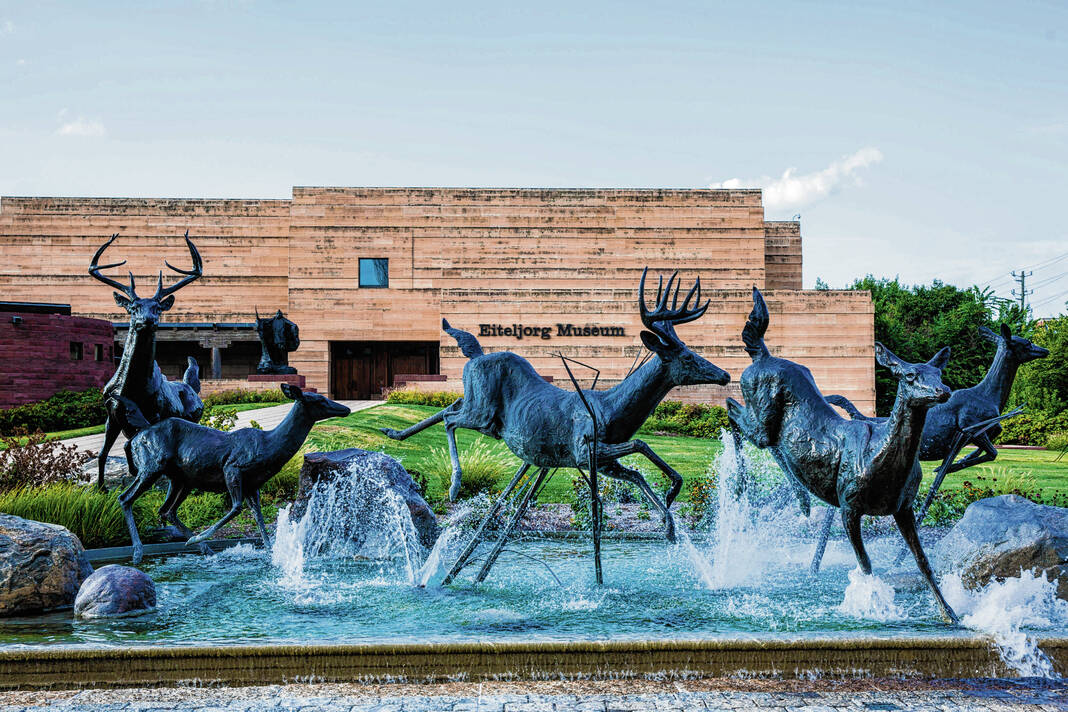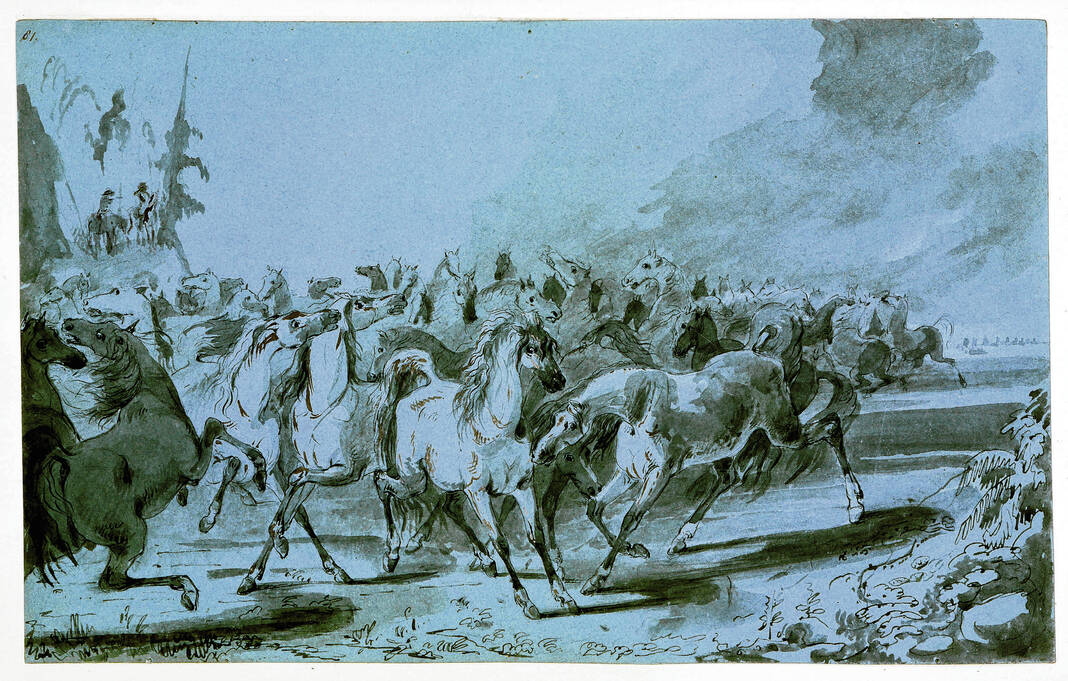
“Trappers Saluting the Wind River Mountains” by Alfred Jacob Miller (1810–1874, United States), ca. 1864. Provided by the Buffalo Bill Center of the West, Cody, Wyoming. Gift of The Coe Foundation. The piece is part of a new exhibition at the Eiteljorg Museum in Indianapolis, “Alfred Jacob Miller: Revisiting the Rendezvous in Scotland and Today,” which opens Saturday.
SUBMITTED PHOTO
The scenes of the American West had been hidden inside a Scottish castle for years.
Paintings and drawings showed a legendary gathering known as the Rocky Mountain Rendezvous of 1837, during which Native peoples met with European-American fur traders along the Green River in what was then Wyoming Territory. The works by Alfred Jacob Miller depicted exotic wildlife, stunning landscapes and Native culture few had encountered.
Each is a unique, often romanticized view of different cultures. And for the first time in more than a century, they’ll be on display together again.
“All of these works haven’t been seen together for 100 years or more. It’s one of those really rare opportunities to pull together some pieces and show them in context with one another, which is how they were meant to be seen,” said Johanna Blume, Eiteljorg curator of Western art, history and culture.
“Alfred Jacob Miller: Revisiting the Rendezvous in Scotland and Today” opens at the Eiteljorg Museum Saturday, where it will be on display at the museum through Jan. 26, 2025. Brought to Indianapolis as a joint venture between the Eiteljorg and the Buffalo Bill Center of the West in Cody, Wyoming, the exhibition is a collection of brilliant paintings, watercolors and drawings of the historic Rendezvous.
“They reached out to me to see if we’d be interested in collaborating — it was a show they were planning to do and were looking for a partner on,” Blume said. “We have some great Alfred Jacob Miller’s in our collection, so it was an immediate fit for us. It made perfect sense to be the show we’d want to do.”
Miller’s journey to the Rocky Mountain Rendezvous is as unlikely as it was spectacular. Born in Baltimore, Maryland, in 1810, he went on to study art in Paris and Rome in his early 20s before settling in New Orleans. There, he met the patron who would change his life, William Drummond Stewart. The Scotsman was a wealthy Scottish baron, as well as a military veteran of Britain’s 1815 victory over Napoleon at Waterloo.
Stewart had traveled to North America looking for an artist to accompany him across the Great Plains to the 1837 Rocky Mountain Rendezvous. During their trek, Stewart commissioned Miller to paint what they encountered.
“The story that’s really interesting and begging to be told right now is the relationship between Miller and William Drummond Stewart — how Miller’s main body of work even came into being,” Blume said. “Here’s this artist who was working and doing reasonably well in New Orleans, and he’s plucked from obscurity by this Scottish nobleman. That experience that comes out of the business arrange fuels the rest of his career.”
Miller was the only European-American artist to witness the Rocky Mountain Rendezvous of 1837. Not only were trade goods such as firearms, metal implements and animal pelts exchanged during these annual encampments, the peoples from various cultures and languages formed an intermingled community lasting days or weeks.
The event was a blend of camping expedition, trading post, reunion and celebration with hunting, gambling, friendship and camaraderie. Today, the Rocky Mountain Rendezvous is remembered as an important cultural event in Wyoming’s history.
Miller’s sketches created during the Rendezvous were the basis for his later paintings — which for years had populated Stewart’s home, Murthly Castle. After Stewart’s death in 1871, the paintings were sold off and separated.
The upcoming exhibition at the Eiteljorg brings them together once again.
“We talk a lot here at the Eiteljorg about the mythology and iconography of the American West, how those ideas disseminate in culture and become so synonymous of the idea of the American West,” Blume said. “This is part of how that can happen — a wealthy patron commissions a series of paintings for his castle in Scotland, and folks in Scotland are exposed to this imagery, but it’s all through a particular lens.”
In working with the Buffalo Bill Center of the West, exhibition organizers tried to tell the story of the Rendezvous, as well as the friendship and relationship between Miller and Stewart.
Care was given to ensure visitors to the museum understood that the artwork presented is seen through the viewpoint of European-Americans — and are not necessarily true to life.
“Miller’s paintings, especially of Native peoples, were not documentary, and reflect a mix of fact and fiction, as well as his patron’s directives. Miller and Stewart harbored biases and misconceptions of their times, and the exhibition provides necessary context for today’s visitors who might find some of the painting subjects troubling” Blume said.
“Revisiting the Rendezvous” blends Miller’s Stewart-commissioned artworks from several institutions with numerous cultural objects from the fur trade.
To help visitors visualize Miller’s work, the exhibition features two life-sized theatrical vignettes. One scene is a recreation of Miller’s tent during the 1837 Rendezvous. The other depicts a room of Stewart’s hunting lodge at Murthly Castle.
Eiteljorg organizers have planned a number of public events and activities to supplement “Revisiting the Rendezvous.” On Saturday, Blume will lead a 1 p.m. gallery tour of the show. Visitors will be able to try out sketching the gallery; supplies will be provided. The activities are included with regular admission.
As the Eiteljorg heads into its Quest for the West Art Show and Sale in September, playwright Gregory Hinton will give a stage performance on Sept. 8 based on Miller’s personal journal entries from his travels in the West. The show is followed by a gallery walk and Q-and-A with Blume and curator Karen McWhorter of the Cody museum. The event requires registration; visit quest.eiteljorg.org for details.
“I hope people are delighted by the work itself and the beauty of Miller’s work. But I hope is also challenges them to think about some of those Western tropes or cliches about what the American West was like historically,” Blume said. “So much of this body of work was about community — his traveling party, the associated guides and hunters and other folks who came along with them, so there’s a lot of camaraderie depicted. It challenges the notion of a rugged individualist Western experience.”
IF YOU GO
“Alfred Jacob Miller: Revisiting the Rendezvous in Scotland and Today”
What: A new exhibition featuring brilliant paintings, watercolors and drawings of the historic Rocky Mountain Rendezvous of 1837, paintd by Miller. The exbhition is done in partnership with the Eiteljorg Museum and the Buffalo Bill Center of the West.
Where: Eiteljorg Museum, 500 W. Washinton St., Indianapolis
When: Opening Saturday, running through Jan. 26, 2025.
Cost: Exhibition is included with the price of admission, which if pre-purchased online is $20 adults, $16 for seniors and $12 for youth.
Information and tickets: eiteljorg.org








